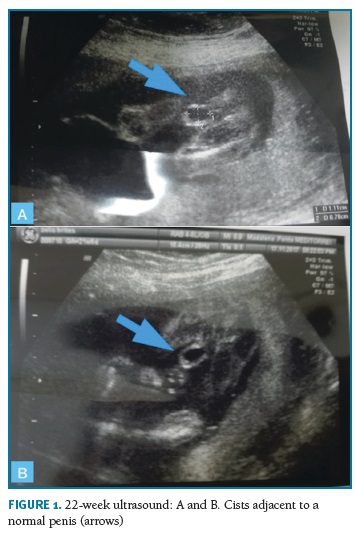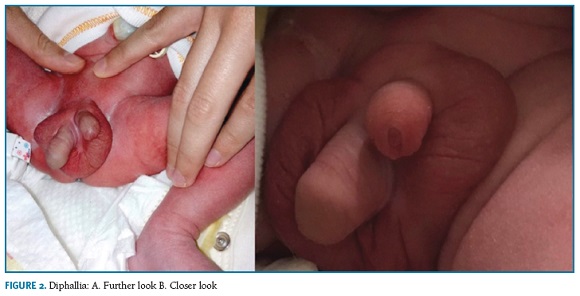Serviços Personalizados
Journal
Artigo
Indicadores
-
 Citado por SciELO
Citado por SciELO -
 Acessos
Acessos
Links relacionados
-
 Similares em
SciELO
Similares em
SciELO
Compartilhar
Acta Obstétrica e Ginecológica Portuguesa
versão impressa ISSN 1646-5830
Acta Obstet Ginecol Port vol.13 no.2 Coimbra jun. 2019
ISSUE IMAGE/IMAGEM DO TRIMESTRE
One plus one equals three!! Penis duplication in a multiple pregnancy
Um mais um igual a três - Duplicação peniana numa gravidez múltipla
Vera Veiga1, Paula Manso1,Madalena Ponte2
Centro Hospitalar de Leiria
1 Assistente Hospitalar de Ginecologia e Obstetrícia
2 Assistente Graduada de Ginecologia e Obstetrícia
Endereço para correspondência | Dirección para correspondencia | Correspondence
ABSTRACT
Diphallia is a rare condition and can be diagnosed antenatally. In this case, a cyst adjacent to the penis of fetus 1 was detected at the second trimester ultrasound. He was born with diphallia with sagittal duplication (the dorsal glans was smaller than the ventral glans). Both phalluses had distinct and independent urethral meatuses and there were no hypospadias. The prognosis depends on whether it is associated or not with other congenital malformations.
Keywords: Duplication; Penis; Pregnancy; Ultrasound.
Description
36 years-old woman, 4 gravida 1 para, with a spontaneous dichorionic twin pregnancy. The 22 weeks ultrasound scan showed fetus 1 with an 10mm anechogenic cyst next to a normal penis (Fig. 1 ) and fetus 2 with normal appearing male genitalia . At 36-weeks of gestation a premature rupture of membranes occurred; fetus 1 was delivery vaginally with 2245g with an Apgar score 9/10/10 and fetus 2 by cesarean section because of non-reassuring fetal heart rate tracing, with 2230g and an Apgar score 8/10/10. Fetus 1 had abnormal genitalia - diphallia (Fig. 2). Both phalluses had distinct and independent urethral meatuses with no hypospadias. There was a sagittal duplication with the dorsal glans smaller than the ventral glans. The scrotum was normal with bilateral scrotum testicles; the anus was normal and there was a small red bump on the sacral region suggesting an hemangioma. An abdominal ultrasound was performed and showed normal kidneys and a minor hydrocele bilaterally. The cystourethrography showed one bladder, two urethras and no vesicoureteral reflux. The newborn had a normal karyotype 46 XY. The other sibling has also an hemangioma; no others anomalies were found.
He is being accompanied simultaneously in Pediatric Urology clinic consultation of another institution for later surgical intervention correction.
Diphallia, penile duplication, is a rare genital anomaly with an estimated incidence of 1:5000000 neonates1. It can be classified in true duplication (two separate penises with two corpora, a urethra and a spongiosum each); bifid phallus/partial duplication (two phalluses sharing a common base); a pseudo duplication (with rudimentary nonfunctional penis) and pseudo phallus (ectopic phalluses)2.
This condition has multiple embryological explanations, but the most accepted is that is a defect connecting the genital tubercle. The meatus may be normal or there can be hypospadias/epispadias. The scrotum can be normal or bifid. In this case there was a sagittal true duplication with normal meatus and normal scrotum with bilateral scrotal testes. Sagittal duplication is the more frequent form, the dorsal glans being usually accessory and hypoplastic.
True duplication is usually associated with other genitourinary malformations such as urinary tract duplication, gastrointestinal anomalies such as anal atresia and rectosigmoid duplication.
The main principle of the surgical treatment is to assure adequate urinary and sexual function with proper cosmesis. Because of the associated congenital anomalies, the type of intervention should be individualized.
Take Home Messages
- Diphallia is a rare condition and can be diagnosed antenatally.
- The prognosis depends on whether it is associated or not with other congenital malformations, such as urogenital or gastrointestinal anomalies.
- Surgical correction is challenging because of its medical, ethical and esthetic decision issues.
REFERENCES
1. Gyftopoulos K, Wolffenbuttel KP et al. Clinical and embryologic aspects of penile duplications and associated anomalies. Urology 2002; 60:675-679 [ Links ]
2. Jesus L.E, Dekemacher S et al. Glans duplication: in depth review and proposal of a new classification. Journal of Pediatric Urology 2017 April;13(2):172-176
Endereço para correspondência | Dirección para correspondencia | Correspondence
Vera Veiga
Centro Hospitalar Leiria, EPE
E-mail: veralfveiga@gmail.com
Recebido em: 26/09/2018
Aceite para publicação: 06/01/2019
















